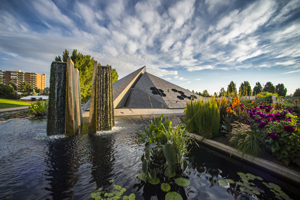The Denver Botanic Gardens opened it new $6-million Science Pyramid to the public on September 18. The 5,258-sq-ft pyramid will showcase the research being done at the gardens on contemporary botanic and environmental issues, as well as topics like global steppe climates.

The new space empowers visitors to become citizen scientists and do their part as ambassadors for global conservation as a part of the Botanic Gardens’ broader mission. Various projects conducted under the Botanic Gardens’ Center for Global Initiatives will also be featured.
The pyramid was designed by Denver’s Burkett Design, with structural engineering work by Boulder’s Studio NYL, and built by Greenwood Village-based GH Phipps Construction Cos.
The pyramid’s high-performance façade is clad in four-ft-wide, hexagonal-shaped, ventilated Swisspearl fiber-cement panels that mimic the geometric efficiency of natural wax honeycombs. Thirty panels feature photovoltaic collectors to gather energy for interior exhibits.
In addition, the central portion of the structure and multiple glass portholes are constructed of electro-chromic glass, which adjusts in opacity from clear to 97% opaque throughout the day based on solar intensity, or at the flip of a switch as the building requires. At sundown, the windows lighten to reveal the building’s colorful interior exhibits and nearby flora.
The project was supported by many generous donations, including $100,000 from the Jonathan Merage Foundation, to fund the extensive enhancements to the featured Omni-Globe.
The interior of the Science Pyramid offers an interactive experience designed by Second Story, part of SapientNitro. Tactile and digital exhibit interfaces help foster a greater understanding of Colorado’s ecosystems and their similarities to others around the world. Special exhibits will highlight the Gardens’ recent work with the city of Ulaanbaatar, Mongolia in an effort to draw parallels between the climates and landscapes of Colorado, Mongolia and Patagonia. The space showcases the Botanic Gardens’ forward-thinking mission and global influence.
“The completion of this extraordinary building is a dream come true,” said Brian Vogt, CEO of Denver Botanic Gardens. “Our new Science Pyramid is inspired by biomimicry, or the imitation of nature. The structure recalls the formation of the Rocky Mountains, as it represents tectonic plates crashing together. Its hexagonal, or honeycomb-inspired, exterior panels pay tribute to the world’s greatest pollinators. The remarkable scientific work of our research and conservation team will be made accessible to all through the technologically advanced exhibits inside.”



Post a comment to this article
Report Abusive Comment